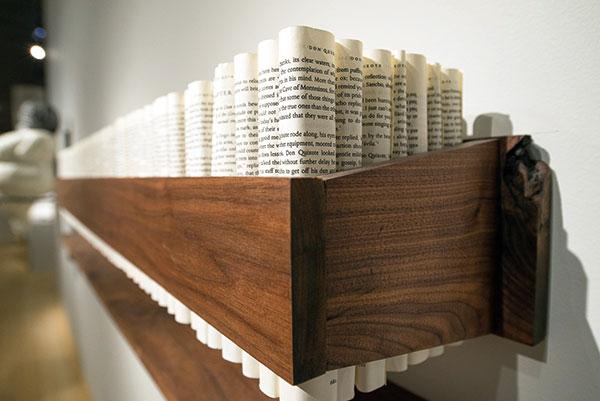
The Gallery at Penn College serves as a cultural asset to Pennsylvania College of Technology and local communities. The Gallery provides the opportunity for the appreciation and exploration of contemporary art, and encourages critical thinking and meaningful experiences.
2025

Re-Writing the Streets 2.0 The International Language of Stickers
January 14 — March 05
2023

John Singletary, Through Lines / Fault Lines
January 17 — March 22

100 Miles, The 2023 Regional Juried Exhibition
June 01 — July 20

Food Justice, Growing a Healthier Community Through Art
August 13 — October 08

Yuji Hiratsuka, Retro Urban Mode
October 24 — December 01
2022

Golden Legacy – Original Art from 75 Years of Golden Books
January 19 — March 30

Journey and Transformation – The Careers of David Stabley & Keith Vanderlin
March 15 — May 06

A Diamond Anniversary, A Celebration of 75 Years of the Little League Baseball® World Series
June 07 — August 25

Lynden Cline, Unavoidable Intimacy
September 08 — October 12

Elle Cee, The Carnival
September 08 — October 12

Geometric Aljamía, A Cultural Transliteration
October 25 — December 02
2021

Sarah Patterson – Second Nature
January 19 — April 09
John Powers – Not a Breath of Wind
March 16 — April 25

Textiles in Translation
June 01 — July 22

Michael Reedy – Into the Void
August 13 — October 08

Jeanette May – Tech Vanitas
October 21 — November 23
2019

The Art of Influence – Breaking Criminal Traditions
January 15 — February 28

Abraham Ferraro – Every Which Way
March 19 — June 27

The Hundred Dresses Project – We Are All In This Together
June 04 — July 23

Michael Hower – Graffiti Scapes
August 16 — October 06

Jeff Repko – In Proximity
October 23 — December 11
2018

Books Undone The art of altered books
January 11 — February 28

Judith Peck – Hope and History
March 13 — April 18

Regional Juried Exhibition 2018
May 29 — June 27

Mindful – Exploring Mental Health Through Art
August 16 — October 11

Jesse Shaw – American Epic
October 25 — December 12
2017

Zahra Nazari - Transformation
January 12 — March 02

Virginia Derryberry – Private Domain
March 14 — April 20

Kay Healy – Vestiges
May 23 — July 23

The National Poster Retrospecticus
August 11 — October 11

Melanie Johnson – The Spaces Between
October 27 — December 07
2016

Robert Gerhardt – Muslim/American American/Muslim
January 14 — March 04

Juan Jose Barboza-Gubo – Intus Externus
March 15 — April 22

Margaret Smithers-Crump – Full Circle
May 24 — June 30

Michelle Ramin – The sky's (not) the limit
July 14 — August 14

Take Ten – The Gallery celebrates a decade of contemporary art
August 25 — October 09

Connected by Stitch
October 22 — December 08
2015

Amanda McCavour – Line Drawn and Stitched
January 13 — March 05

Robin Germany – Sim-Biotic
March 17 — April 23

Ed Smith – Though much is taken, much abides...
May 28 — June 26

Daryl Thetford – The Struggle to Evolve Before the End of Time
July 09 — August 09

Joo Lee Kang – Nature Fathomable
August 18 — September 20

A View Within – A Collaboration of Two Fiber Artists
October 02 — November 02

Mikhail Gubin – Geometry
November 06 — December 11
2014

Frank Lloyd Wright's Samara A Mid-Century Dream Home
January 14 — March 29

Tammie Rubin – Neverwhere and Nowhere
April 08 — May 04

Ned Martin – Before and After
May 29 — June 29

Charles Fazzino – Collective Pop
July 10 — August 24

James Arendt – Those of Us Still Living
September 02 — October 01

100 Works! The Centennial Exhibition
October 10 — November 09

Jennifer R. A. Campbell – Lotus Eaters
November 14 — December 14
2013

Richard Herzog – Urban Landscape
January 11 — February 03

Timothy McCoy – Sanctuary
February 07 — March 07

Merrill Steiger – Worlds Collide
March 19 — April 18

Art Alive! - Lycoming County Juried Art Exhibition
May 30 — June 28

Putsee Vannucci – In the Field of Play
July 12 — August 30

Christopher Olszewski – No Place for the Weak
September 06 — October 06

Lauren Kinney & Patrick Vincent – A Darkness
October 11 — November 10

The Art and Illustrations of Zelda Fitzgerald
November 14 — December 15
2012

Anila Quayyum Agha – Rights of Passage
January 10 — January 22

Out of This World - The Landscapes of Our Solar System
March 13 — April 19

Cathy Breslaw – Illuminations
May 18 — June 28

Terra Incognita – Mosaic Explorations
July 10 — August 26

John Bavaro – Masterpiece Mobile Art on a Wireless Canvas
August 30 — September 30

Bill Wolff & Marcia Wolfson Ray – Natural Elements
October 11 — November 11

Morgan Craig – All of Nowhere Explorations in Architecture and Identity
November 15 — December 16
2011

Mark Khaisman – Likeness of a Likeness
January 08 — February 02

Jeff Mann – Auto Response
February 08 — March 04

Denis Peterson – Paintings
March 15 — April 20

Meredith Setser – Floreal Stratum
May 19 — June 26

Doug Tausik – Bodies Under Pressure
July 12 — August 21

Cheryl Agulnick Hochberg – Animal Instinct
August 26 — September 28

Kaleidoscope - The Alumni Exhibit
October 07 — November 06

Virginia Bradley & Chris Malcomson
November 11 — December 11
2010

Shalya Marsh – Cipher
January 09 — February 09

Dana Fritz – Garden Views and Terraria Gigantica
February 16 — March 28

Lauren Schiller & Tom Baker – Prints and Paintings
April 06 — May 05

The Art of Education - North Central PA Regional Art Teacher Exhibition
May 20 — June 27

Full Deck - A Short History of Skate Art
July 22 — September 22

Antonio Puri – I AM
October 07 — November 07

Renee Zettle-Sterling – Objects of Mourning
November 11 — December 14
2009

60 x 60 - Small Prints from Purdue University Galleries
January 10 — February 03

Ed Wong-Ligda – Beauty, Vulnerability and Inevitability
February 10 — March 06

Nick Johnson – Transcendence
March 17 — April 09

Miguel Tio – Artist in Residence
April 21 — April 24

Penn College Proud Showcase - Employee Exhibition
May 14 — June 30

Cheryl Tall & Ceil Sturdevant – Arrested Motion
July 09 — August 19

Evan Summer – Prints, Drawings and Collages
August 25 — September 27

Were You There? The Evolution of a College Campus
October 06 — November 08

Indo-American Arts Council's Erasing Borders 2009
November 13 — December 13
2008

Maureen Drdak – Planes of Aspiration
January 15 — February 12

Gary Mesa-Gaido – Public Spaces of Europe
February 19 — March 14

Brian D. Cohen – The Fool's Journey
March 30 — April 25

Fred T. Gilmour – Searching for Creativity
May 16 — June 22

Japan Juxtaposed - Traditional Textiles/Modern Images
July 08 — August 06

Brad Holland – Third Eye
August 14 — September 14

Judith Kalina – New Paintings
September 19 — October 16

Brian Bishop – [pause]
October 26 — November 21

David Armstrong – Exalting Everyday Elements
December 02 — December 17
2007

Ray Gloeckler – Works from Wood
January 23 — February 18

Timothy Hawkesworth – Paintings and Drawings
February 27 — April 01

Cynthia Harper – Applied Landscape
April 10 — May 06

Dr. Kenneth E. Carl – Visions in Wood
May 15 — June 17

Where Science Meets Art
June 21 — August 31

Jason Godeke – Object and Figure Paintings by Jason Godeke
September 09 — October 02

Florence Putterman – Interwoven Dialogues
October 09 — November 04

Kim Banister – Vessels of Life
November 09 — December 01

David Armstrong & Chris Armstrong – Returning Home
December 08 — December 16
Mayuko Ono Gray 諸行無常 This too, shall pass
Exhibit dates Hours/Calendar
Mayuko Ono Gray’s exhibition, 諸行無常 –This too, shall pass, features the artist’s monumental graphite drawings that juxtapose Japanese calligraphic forms with depictions of the people, animals, and still lifes captured in her daily experiences. Reflecting on her life, which is culturally both Japanese and American, Ono Gray’s graphite drawings hybridize influences from traditional Japanese calligraphy combined with Western drawing practices and aesthetics. Each drawing is titled with a Japanese proverb spelled out with hiragana and kanji characters intertwined to create a single line from the top right to the lower left of the pictorial space, following traditional Japanese writing format. The line serves as a metaphor for life and the path taken from birth to death. Through this work Ono Gray navigates her position living between two cultures and languages.
Mayuko Ono Gray is an artist based in Houston, Texas, whose primary medium is graphite drawing. Born in Japan, she was trained in traditional Japanese calligraphy in her youth and later studied classical Western drawing. Ono Gray moved to the United States following high school and went on to receive an MFA in painting from the University of Houston in 2007. Her work has been exhibited extensively in the United States and abroad, including exhibitions in Japan, Mexico, Germany, Italy, UK, and Greece. Her works are represented by Hooks-Epstein Galleries in Houston and Galeria 910 in Oaxaca, Mexico.





















